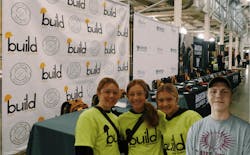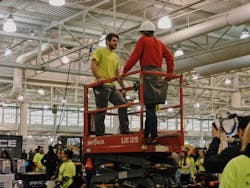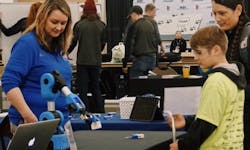Construction’s Next Generation: Insights From Build My Future 2022
The 2022 Build My Future event in April in Des Moines, Iowa, offered an optimistic glimpse into the evolution of the skilled trades, proving that in a time of unprecedented labor shortages and industry obstacles, workforce development in the construction industry is still alive and well.
Build My Future is a national workforce development initiative started in 2019 in Springfield, Mo., to highlight careers in construction through an interactive showcase of hands-on training provided by local employers, educators, and skilled trades associations. In the event’s inaugural year, 1,871 students from a 19-county area with 74 schools represented attended.
Since then, Build My Future has grown to include events in Arkansas, Florida, Iowa, New Mexico, Oklahoma, Oregon, Pennsylvania, Texas, and Wisconsin. Among the 5,000 students in attendance in Des Moines this year were Iowa high schoolers Nate Friedhoff, who is a junior from the Johnston Community School District, senior Tyler Binning from the Clarke District, and freshmen Anna Saltzman, Mia Kautman, and Mollie Schnormeier from the Gilbert Community School District. The students expressed their excitement not just about a day of hands-on work, which included rappelling down Deutschland und USA (DEUS) rescue systems and wiring electrical panels, but for what Build My Future’s exposure to the construction industry means for the future of their entire generation.
RELATED
- Pro Builder Attends Third Annual Build My Future [VIDEO]
- The Best-Kept Secret in Solving the Trade Labor Shortage
- Shop Class Resurgence: Can It Help Resolve the Skilled Labor Shortage?
PRO BUILDER: What did you find most interesting about Build My Future 2022?
Tyler Binning: I came here last year and really enjoyed the hands-on activities. I’ve thought about becoming a tower technician, so any resources I can get in that field are great, and there are a lot here.
Mollie Schnormeier: I want to participate in a lot of personalized activities. We’ve done some of the competitions at different booths to practice hammering nails and using power tools, and we’re just enjoying all there is to see here.
Mia Kautman: I’m excited to see the variety of different activities here that we don’t see in our day-to-day lives at school. It’s refreshing to see what other opportunities are out there.
PB: Why do you think it’s important for students and young adults to have resources and exposure to the skilled trades at events like this one?
TB: A lot of high school students are told to just go to college, and that’s been the standard for decades. I think it’s good to have events like this because they can open people up to other possibilities. These events allow everyone to get around misconceptions about the trades and start more clear communication about how to build up the industry.
MS: My dad is really knowledgeable about the trades and does a lot of hands-on work and he’s taught me a number of essential skills. I think this kind of information is really important, even for everyday life. If I need to get something done, I won’t need to watch a YouTube video or reach out for help. I want to know how to create or fix things, and I want to be able to do it well.
Anna Saltzman: The next generation is going to need to know how to take over. People in these positions now aren’t going to be there forever. We need to be prepared to step up when our time comes.
Nate Friedhoff: Without this kind of exposure, the industry will die, and these are essential jobs that keep our whole country running. We’re really needed, so it’s nice to get information about where to start.
PB: How do you expect your generation to shape the future of the skilled trades? What impact do you hope to have?
TB: I expect a lot of growth in the skilled trades. The whole industry is really starting to boom and young people are getting involved as they come to realize that they’re not failing themselves by not going to college. It’s important now especially because labor is really needed everywhere and it’s hard to find people who really want to work.
MS: We have a lot to offer. Even just bringing our personalities to the table will be a fresh change and I think a lot of students are ready to expand on what they already know.
MK: There are new techniques for getting work done. There’s an emphasis on technology here at Build My Future and we can be the ones creating new innovations and running everything. We might be able to make systems work more quickly or more efficiently.
NF: I think my generation can fill a lot of the gaps that will be left behind when older workers retire, and we have the drive to do it, so I expect we’ll make a mark when our time comes.
RELATED
- How Should Construction Hiring Managers Connect With the Next Generation?
- What Would You Tell Your Rookie Self, Vol. 2 [VIDEO]
- HBI President Ed Brady’s Call to Action to Solve the Labor Shortage
PB: How can builders and trade leaders better connect with younger generations and improve outreach and education?
TB: Definitely through social media. Our attention often gets redirected to our phones, so if they can connect with us there, they’ll get our attention.
NF: I agree. A lot of younger people are active on social media, so I think that if building companies had more of a presence there, they could recruit young adults coming up into these fields. Job fairs and events like this are great, but social media, marketing, and advertising can reach a bigger audience and attract more workers.
PB: How has being a high school student during the COVID era shaped your outlook on the job market and your path forward after graduation?
MS: Honestly, it’s made me realize I just don’t want to do something boring. I want to do something hands-on and stimulating, and I don’t want to be tied down. I don’t want to stay in one place for a certain amount of time, and there’s a lot more freedom in the job market now. COVID helped me decide to take advantage of that.
TB: It’s given all of us a lot of drive, I think. We’ve shown that we can be resilient, and that’s a trait that will carry over into the workforce. I came to this event a year ago during the pandemic and did some of the same activities I’m also doing today. That exposure in a time when in-person job fairs and one-on-one resources are hard to come by has solidified my interest in the trades.
PB: I’ve seen a lot of young women on the floor today actively participating in the challenges and activities on display. What does that representation mean for all of the women in attendance?
MS: It shows that women can do whatever men can do. It’s not about gender. It’s about getting the work done, and I think our presence here shows that we’re capable.
AS: I think that if young girls have more female role models, then they may look at male-dominated occupations and think, “Oh that’s cool. I want to do that, too.” The next generation of female workers can inspire even more to join after them, and that starts with us, I think.



